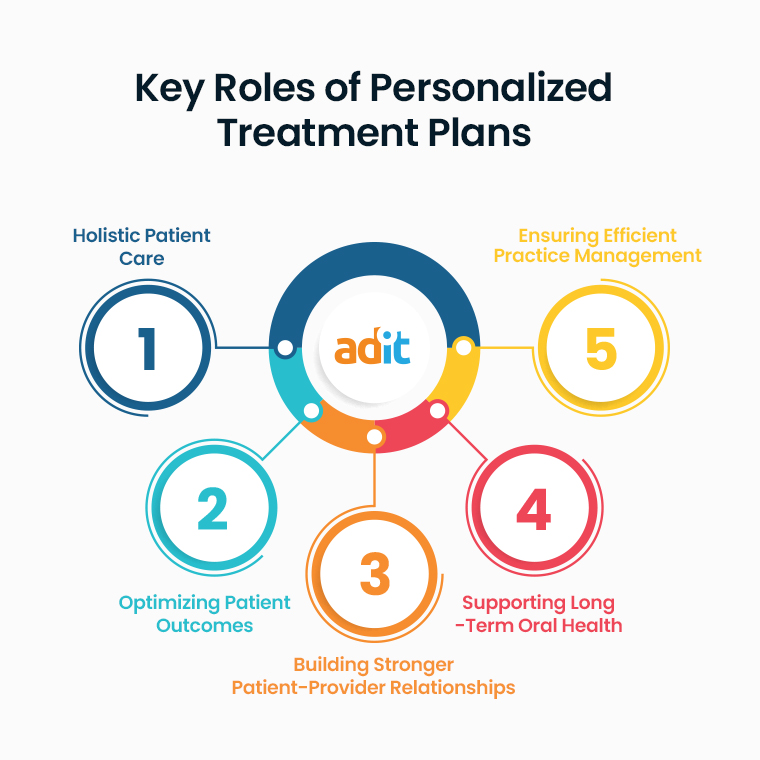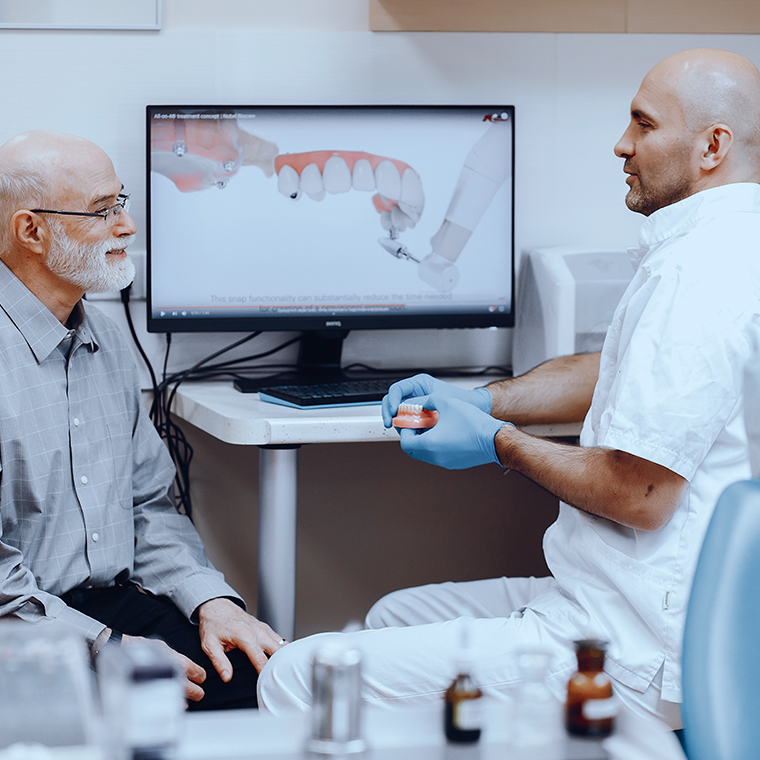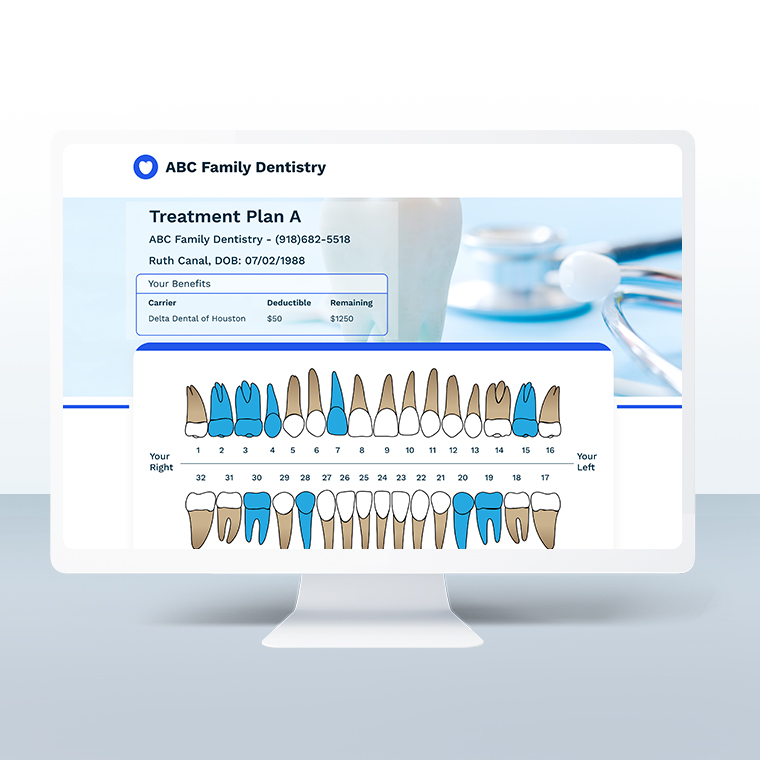Ends in
ends in 103 Days

ends in 103 Days

ends 11 July
Crafting the Perfect Dental Treatment Plan: Key Elements You Need to Know

Creating a customized treatment plan for dental patients is key to providing quality care and ensuring positive results. A good care plan not only addresses clinical needs but also takes into account their preferences, lifestyle, and budget. With the help of cloud-based dental treatment plan software, this process has helped dentists become more efficient, patient-focused, and results-oriented.
This guide will walk you through the key elements of effective patient treatment plans and explain how treatment planning software can enhance both patient care and practice workflows.
The Importance of Personalized Treatment Plans

A well-crafted dental treatment plan is more than just a list of procedures—it's a roadmap designed to address each patient’s unique dental health journey. Personalized care is at the core of modern dentistry, ensuring that patients receive the exact treatments they need when they need them. From the first consultation to the final follow-up, a thoughtful treatment plan paves the way for better health and long-term satisfaction.
Dental treatment plan software helps dentists meet the specific health goals and challenges of each patient they treat, offering a level of precision and personalization that improves long-term outcomes. The true power of a well-constructed dental treatment plan lies in its ability to enhance patient care, improve communication, and ultimately, ensure long-term oral health.
Key Roles of Personalized Treatment Plans
- Holistic Patient Care: Personalized treatment plans serve as the backbone of holistic patient care. It integrates all aspects of one's oral health, addressing not just immediate issues but also preventive care and long-term maintenance. This comprehensive approach helps avoid the "one-size-fits-all" mentality, ensuring that each patient receives care tailored to their specific health needs and goals.
- Optimizing Patient Outcomes: By creating a dental treatment plan that’s customized to a patient's unique situation, dental professionals can focus on improving outcomes. Whether the goal is pain relief, restorative care, or aesthetic enhancements, the plan allows for targeted treatments that result in more effective and satisfying results, minimizing the risk of complications or delays in healing.
- Building Stronger Patient-Provider Relationships: One of the most important roles of dental treatment plan software is to foster clear communication between patients and their dental providers. When patients understand their treatment options and feel empowered to make informed decisions, it builds trust and increases engagement, leading to better adherence and overall satisfaction.
- Supporting Long-Term Oral Health: Treatment plans are essential for preventing future dental problems. By addressing potential risks early on and incorporating regular maintenance into the plan, dental professionals can help patients maintain optimal oral health for years to come. This proactive approach can significantly reduce the need for more invasive treatments later on.
- Ensuring Efficient Practice Management: From the dentist’s perspective, dental treatment plan software also streamlines practice operations. With a clear and structured plan in place, dental teams can efficiently coordinate care, monitor progress, and ensure that patients stay on track with appointments and follow-up treatments. This organization not only benefits the patient but also improves the overall workflow of the practice.
As you can see, patient treatment plans are more than a necessity—they're a game-changer in the world of dentistry. When dentists get patients actively involved in the decision-making process, the result is a partnership built on trust, knowledge, and the shared goal of achieving optimal oral health.
Crafting the Perfect Dental Treatment Plan: Key Elements for Success

Creating the perfect dental treatment plan is essential for providing top-notch care and ensuring the best outcomes for your patients. A well-structured oral healthcare plan not only addresses each patient’s specific needs but also boosts their understanding and engagement in the treatment process. Here’s a look at the key elements dentists should consider when developing effective treatment plans, along with specific examples to illustrate each point.
1. Comprehensive Patient Assessment
The first step in crafting successful patient treatment plans is conducting a thorough patient assessment. This means taking the time to evaluate the patient’s medical history, current oral health status, and any concerns they may have. For example, if a patient has a history of gum disease, this will significantly impact their treatment options and timeline.
2. Clear Diagnosis and Treatment Goals
After the assessment, it’s important to provide a clear diagnosis. If a patient comes in with tooth sensitivity, diagnosing it as a cavity or gum recession helps set clear treatment goals. You might aim for pain relief through a filling or recommend gum grafting if the gums are receding. Clearly defined goals ensure both you and the patient understand the intended outcome.
3. Customized Treatment Options
Every patient is unique, so offering tailored treatment options is crucial. When a patient is interested in teeth whitening, discuss different methods like in-office bleaching versus take-home kits. This allows the patient to weigh their options based on factors like time, cost, and effectiveness, ultimately leading to a decision they feel comfortable with.
4. Detailed Breakdown of Costs and Insurance Coverage
Transparency is key when it comes to costs, and modern dental treatment plan software offers customizable presentation options to share this information with your patient. Imagine a patient needs a root canal and crown and you can provide a clear breakdown showing the costs for each procedure, what their insurance covers, and any out-of-pocket expenses. This approach helps prevent any surprises and builds trust with your patients.
A Brush Above Family Dentistry gains 60+ new patients a month with Adit Looking for a single system to reduce front desk chaos and convert more calls? After switching from Comcast and Solutionreach to Adit’s all-in-one...
Schedule a Demo5. Emphasis on Patient Education
Educating patients about their treatment is essential for compliance. For example, if you recommend a night guard for a patient who grinds their teeth, take the time to explain how it protects their teeth from wear and tear. Providing brochures or links to informative videos can further enhance their understanding and encourage them to follow through with the recommendation.
6. Use of Technology for Visualization

Incorporating advanced dental technology can make a big difference in how patients understand their treatment options. For instance, using a 3D model to show a patient how a dental implant will fit into their mouth can help them visualize the end result. This clear representation can boost their confidence in the treatment and increase acceptance rates.
7. Collaboration and Communication
A successful treatment plan relies on effective teamwork. Encourage open communication among your dental staff. For example, if a dental hygienist identifies a potential cavity during cleaning, they should feel comfortable discussing this with you right away. Regular team meetings can help everyone stay on the same page regarding each patient's treatment progress.
8. Continuous Progress Tracking
Monitoring how patients respond to their treatments is critical. For example, if a patient is undergoing orthodontic treatment, regularly checking their progress with progress photos and adjusting the treatment plan as needed is essential. This flexibility allows you to address any issues promptly and keep the patient informed and engaged.
9. Patient Follow-Up and Support
After the treatment plan is put into action, don’t forget about follow-up care. Establish a system for checking in with patients, whether through phone calls, emails, or patient portals. For example, after a patient has a tooth extraction, a quick follow-up call to see how they’re healing can provide reassurance and encourage them to reach out if they have questions or concerns.
By incorporating these key elements, dentists can create effective dental treatment plans that prioritize patient needs and promote positive outcomes. From comprehensive assessments and clear diagnoses to customized options and ongoing support, each element plays a vital role in delivering quality care. Ultimately, a well-executed treatment plan enhances the patient experience, builds trust, and leads to successful treatment compliance, making both the dentist and the patient happy in the process!
The Future of Dental Treatment Planning

As technology continues to evolve, dental treatment planning is poised to become even more sophisticated. Emerging trends such as artificial intelligence (AI) and tele-dentistry will significantly shape the future of treatment planning. AI-driven tools may assist in diagnostics, treatment recommendations, and predicting patient outcomes based on historical data, while remote consultations will allow dental professionals to provide care and guidance without requiring in-person visits.
To remain at the forefront of patient care, dental professionals must commit to continuous learning and adaptation as new technologies and methodologies emerge. Embracing advancements in dental treatment plan software will empower practices to deliver high-quality care that meets the diverse needs of their patients.
Adit Treatment Planning: Elevate Your Practice with End-to-End Solutions

If you're looking to enhance your treatment planning process, Adit’s comprehensive practice management software is the all-in-one solution designed specifically for dental professionals. Adit is more than just a treatment planning tool; it’s an entire ecosystem of features that streamlines your workflows, boosts patient engagement, and drives practice growth. By choosing Adit, you’ll gain access to cutting-edge technology that supports every aspect of your operations—from scheduling to billing and beyond.
Key Features of Adit
Here are just some of the fantastic features Adit offers to elevate your practice:
- Treatment Planning: Provide a transparent and informative case presentation experience for your patients to make informed treatment decisions.
- Real-Time Online Scheduling: Allow patients to manage their appointments without having to call into your office, reducing administrative burdens and increasing satisfaction.
- Adit Voice: Centralize communication for efficient coordination across your practice with our VoIP phone system.
- Automated Reminders and Follow-Ups: Maintain continuity of care by ensuring patients stay on track with their treatment plans with automated confirmations and reminders.
- Patient Text: Seamless communication with patients via text, ensuring critical messages are never missed.
- In-House Chat: Improve collaboration among your team with instant messaging for quick inquiries and updates.
- Adit Pay: Automated billing tools simplify financial management and streamline collections.
- Patient Recall Tools: Stay connected with patients to increase appointment retention and reduce gaps in care.
- Call Tracking and Recording: Monitor patient interactions and dive into the effectiveness of your ad campaigns with our comprehensive communication tools.
- Exclusive CareCredit Integration: Connect qualifying patients with flexible payment options to make treatment more accessible and boost acceptance rates.
- Advanced Analytics and Reporting Tools: Track metrics and generate insights into practice performance and patient demographics to tailor your services more effectively in real-time.
- Dental Digital Marketing Support: Engage with patients through targeted marketing campaigns and promotions.
- Centralized Recordkeeping: Maintain organized, secure patient records for streamlined access and compliance.
- Mobile App: Empower your team and patients to collaborate from anywhere with our feature-rich mobile app.
With Adit’s fully integrated platform, dental professionals have everything they need to streamline treatment planning, enhance patient satisfaction, and achieve better clinical outcomes. Schedule a free demo today and experience the benefits of comprehensive practice management software!
more about Adit?
Access a full suite of patient communication tools with Adit! Texting, payments, reviews, & scheduling in one place.
Schedule a DemoJosh has made a career working with large DSO organizations and leveraging his extensive sales experience to build partnerships with influential doctors and organizations within the dental industry. He travels the US as an expert guest speaker in medical seminars teaching doctors how to streamline their practices with the latest technology.
Get a $25 Gift Card when you take a demo
Schedule a Demo
Get a $50 Gift Card
when you take a demo
Looks like you're out of bounds!
Hey there! Your current location falls outside Adit's area of operation. If this is unexpected, try disabling your VPN and refresh your page. For further assistance or to book a live demo, connect with us at 832-225-8865.
December 14 Amazon Demo Promo
Terms and Conditions
Last Updated: December 14, 2025Offer ends December 17, 2025, and is limited to prospective customers who sign an annual agreement before December 31, 2025. Gift card will be emailed to the company owner or established representative within 4 weeks of signing the annual agreement. Offer may not be combined with any other offers and is limited to one (1) gift card per office. Offer is not available to current customers or to prospective customers or individuals that have participated in a Adit demo during the prior six (6) months. Recipient is responsible for all taxes and fees associated with receipt and/or use of the gift card as well as reporting the receipt of the gift card as required under applicable federal and state laws. Adit is not responsible for and will not replace the gift card if it is lost or damaged, is not used within any applicable timeframe, or is misused by the recipient. Adit is not responsible for any injury or damage to persons or property which may be caused, directly or indirectly, in whole or in part, from the recipient’s participation in the promotion or receipt or use of the gift card. Recipient agrees to indemnify, defend and hold harmless Adit from and against any and all claims, expenses, and liabilities (including reasonable attorney’s fees) arising out of or relating to a recipient’s participation in the promotion and/or recipient’s acceptance, use or misuse of the gift card. This offer is sponsored by Adit Communications, Inc. and is in no way sponsored, endorsed or administered by, or associated with Amazon.
Thank You!
We appreciate your interest! Adit AI will be calling you in the next few minutes!
Why Adit?
Cut your software bill by up to 60% when you merge everything your dental office needs to run under one roof.
Centralize Communications
- Phones & TeleMed
- Emails & eFax
- Texting & Reminders
- Call Tracking and more!
Streamline Operations
- Patient Forms
- Online Scheduling
- Payments
- Reviews and more!
Boost Production
- Performance Dashboards
- Morning Huddle
- Claims & Collections
- Patient Profiles
- Follow Up Lists
- Year Over Year Metrics
Acquire More Patients
- Digital Marketing
- Website Design
- SEO
- Google Ads
- Facebook Ads
Ends in

when you sign up with Adit!
Sign up by filling out the form







